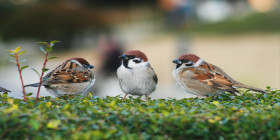Do you miss the chirruping of sparrows outside your window when you wake up in the morning? We’re sure you must have noticed how sparrows have slowly vanished from view since the past few years.
Once found in huge numbers across the world, the small bird is slowly making its way to the endangered list and looks like humans are to blame.
March 20th is a day designated to celebrate house sparrows. Ever since the threat to their population is growing at an alarming rate, the Nature Forever Society of India in collaboration with the Eco-Sys Action Foundation (France) and numerous other national and international organisations across the world took a step toward taking this international initiative.
Conservationist Mohammed Dilawar has said that the reason behind the house sparrow inching towards extinction is lack of emotional connect.
The house sparrow that was declared the ‘State Bird of Delhi’ in 2012 is becoming a victim of ‘mindless urbanisation’, which is depriving the bird of its natural habitat.
“Common sparrows are going extinct because of mindless urbanisation. They are losing not just their natural habitats but also the essential human touch they need and thrive upon.
“The current generation is so much surrounded by technology that they have forgotten about nature. The indifference caused by a lack of emotional connect has pushed these birds to the edge of extinction,” Dilawar, who also founded Nature Forever Society for India (NFSI), a non-profit organization to conserve house sparrows, told PTI.
The conservationist also attributed the depleting population of sparrows to the increased use of packed food, insecticides in farming, and changing lifestyles, resulting in an inadequate availability of food for the birds.
“Earlier women used to clean grain outside their houses and sparrows would have plenty of food from there. Also the severe use of insecticides in farming is killing sparrows’ primary food source in insects and grains,” says Dilawar.
Sparrows are also rendered homeless, he says, due to the “matchbox styled” architecture that makes it difficult for the birds to locate pockets to build nests.
“Unlike pigeons that can make nests on ledges, sparrows need cavities to build their nests. Since the new matchbox style buildings don’t have cavities, sparrows are now homeless,” he says.
Founded in 2005, NFSI works actively to spread awareness for bird conservation, besides distributing bird feeders and nest boxes to solve to some extent the scarcity of food and nests.
With summer approaching, Dilawar suggests people should hang wooden bird nests in balconies and put out a pot of water for the winged visitors.
To track the number of sparrows in the area, the institution also observed a three-day ‘Great Sparrow Count’ starting March 18, during which birdwatchers uploaded bird counts in their respective localities on to a common database.




Leave a reply